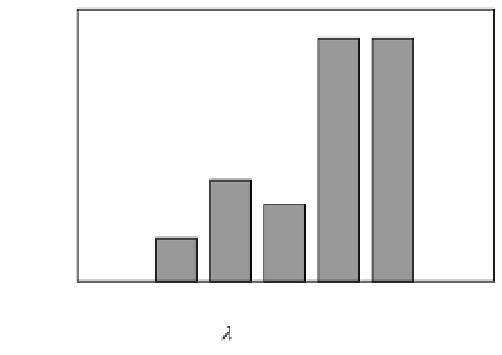Environmental Engineering Reference
In-Depth Information
100
10
80
8
60
6
40
4
20
2
0
0
-1.05
1.06-
1.10
1.11-
1.15
1.16-
1.20
1.21-
1.25
1.26-
1.30
1.31+
0-5
6-10
11-15 16-20
20+
Years since release into first patch
Growth rate ( ) of translocated population
Fig. 7.4
Probability of successful colonizations in
relation to the number of years since release in the
first patch for 31 translocated populations of bighorn
sheep released 1947-91. After Singer
et al.
(2000).
Reproduced by permission of Blackwell Publishing.
Fig. 7.3
Probability of successful colonizations of new
patches is correlated with population growth rates (
)
of 31 translocated populations of bighorn sheep in the
western USA in 1946-97. After Singer
et al.
(2000).
Reproduced by permission of Blackwell Publishing.
λ
Singer
et al.
(2000) related the fate of a number
of bighorn sheep re-introductions to this species
naturally occurring in metapopulations. At present,
most extant populations of bighorn sheep (
Ovis
canadensis
) consist of fewer than 100 individuals
occurring in a fragmented distribution across the land-
scape, whereas the species formerly occupied a more
continuous and wider range. They investigated the
correlates for the rate of colonization of 79 suitable,
but unoccupied, patches by 31 translocated populations
of bighorn sheep released into nearby patches of hab-
itat. Dispersal rates were 100% higher in rams than in
ewes. Successful colonizations of unoccupied patches
(24 out of 79 patches were colonized) were associated
with rapid growth rates of the released population
(Fig. 7.3), years since release (Fig. 7.4), larger area of
suitable habitat in the release patch, larger popula-
tion sizes and a seasonal migration tendency in the
released population (Fig. 7.5). In this study area, colon-
ization rates were much higher than other studies
have reported and this could be attributed to the pres-
ence of larger regions of unoccupied suitable habitat
with a greater probability for detection than the other
studies. It is possible that bighorn sheep existed
mostly in metapopulations but that human disturbance
has accelerated extinction rates in these metapopula-
tions, and that bighorn sheep now occur in a non-
equilibrium state. The results of this study also
60
50
40
30
20
10
0
Non-
migratory
Partially
migratory
Migratory
Migratory tendency
Fig. 7.5
Probability of successful colonizations in
relation to migratory tendency in the release patch
for 31 translocated populations of bighorn sheep.
Migratory, > 75% of the population uses distinct
seasonal changes; partially migratory, part of the
population migrates; non-migratory, year-round
use of the same ranges. After Singer
et al.
(2000).
Reproduced by permission of Blackwell Publishing.
indicate that many restoration projects in the past
probably suffered from poor procedures. Many prior
translocations consisted of small founder groups
(typically fewer than 25 animals) released into small,
isolated patches of habitat, probably representing a
near-perfect prescription for failure.








